Apple's iPhone 4: Thoroughly Reviewed
by Brian Klug & Anand Lal Shimpi on June 30, 2010 4:06 AM EST- Posted in
- Smartphones
- Apple
- iPhone 4
- Gadgets
- Mobile
I'm not sure how this keeps happening. The first year I waited at a mall for 5 hours to get the original iPhone. The following year my friend Mark Rein convinced me to see a midnight showing of Hellboy II and then wait outside of an AT&T store all night to get the iPhone 3G. You'd think I'd learn by the third year but once more I was in line at the mall hours before the Apple store opened to get the 3GS. This year I thought it would be different. Apple offered free overnight shipping to anyone who wanted to pre-order the iPhone 4. Figuring everyone would go that route I decided to beat the FedEx trucks and just show up at the mall at 6AM. I'd be in and out in a little over an hour, which would give me a head start on battery life testing on Apple's 4th generation iPhone.
I promise that not all of my decisions play out this poorly. Those who pre-ordered the 4 and requested overnight delivery got their phones early and my one hour wait turned into six hours at the mall, for the fourth year in a row.
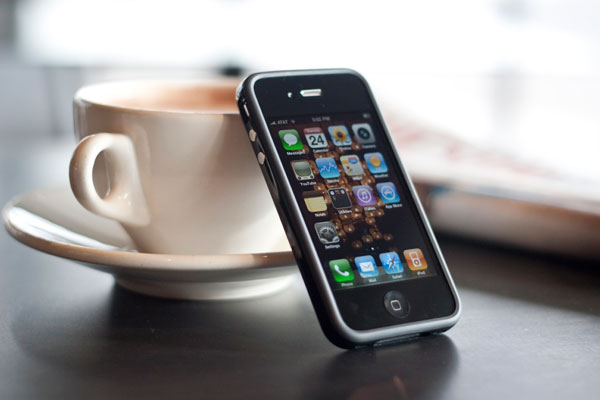
Apple's iPhone 4 with Bumper Case
It's a self fulfilling prophecy. Steve gets up on stage, proclaims the iPhone 4 to be the biggest introduction since the original iPhone, and the public flocks to Apple stores to fork over $200 on day one and around $2500 over the course of two years for the privilege. But this isn't 2007. Apple has real competitors in the smartphone space. Android phones have grown in features, polish and popularity. Even Palm entered the race with a competant offering, and Microsoft isn't far behind. It's easy to start a revolution when everyone else is doing the wrong thing, but what about when more companies actually get it? Was Steve justified in his excitement over the 4? That's what we're here to find out today.
Straight on it looks like just another iPhone. You get the black face with a shiny trim. From the side it is the redesign that Apple has needed for a while now. It’s not revolutionary but it’s the type of improvement that makes its predecessor feel old. And that’s exactly what this does. Have a look for yourself:
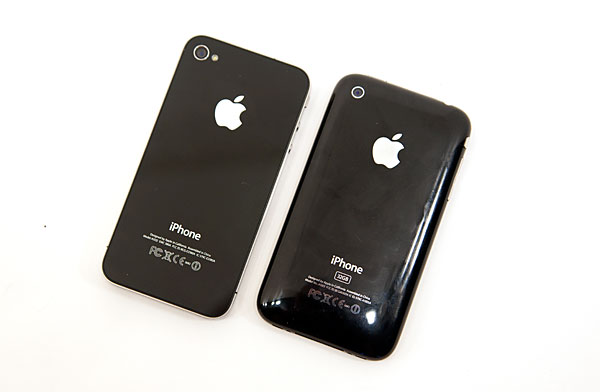
iPhone 4 (left) vs. iPhone 3GS (right)
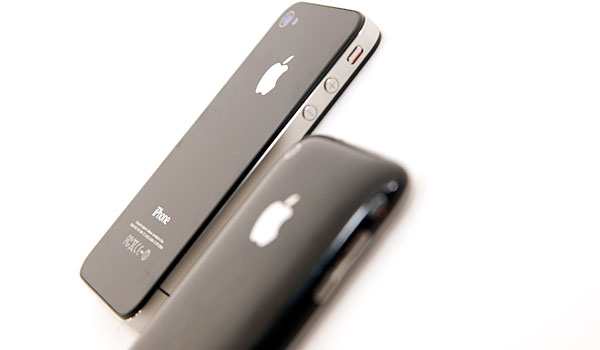
The straight lines, smaller dimensions and lack of unnecessary bulk make the 3GS feel like a car from the 90s, unnecessarily curvy. The styling is now so much more compact. Compared to the iPhone 3GS the 4 is around 5% narrower (but no more difficult to type on) and nearly 25% thinner. It even makes the Nexus One look dated:
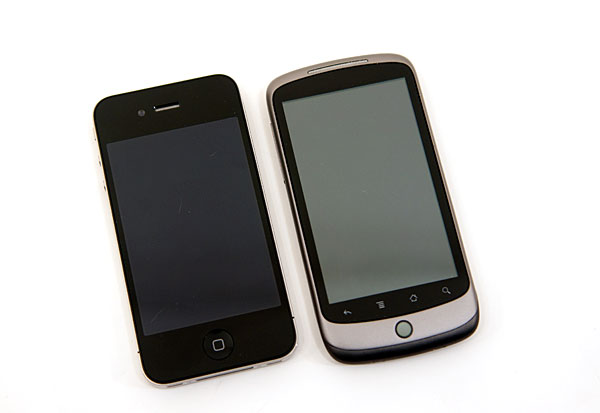
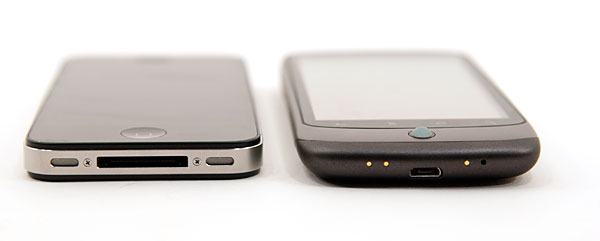
The iPhone 4 is slightly heavier than the 3GS (4.8oz vs. 4.7oz). You feel the added weight but I wouldn't call it heavy. The front and the back of the iPhone 4 are both made out of glass, and they protrude beyond the stainless steel band that wraps around the phone (more on this controversial decision later). While this gives the 4 an amazing finish, it also makes carrying the phone nerve racking. Coupled with the smaller, more dense form factor I’m now deathly afraid of dropping and shattering this thing. Apple has done a lot to reinforce the glass, however there have been enough reports already of shattered iPhone 4s for me not to feel very safe. Only Apple would think to make the two surfaces most likely to hit something out of glass. It's like making mouse traps out of cheese, something bad is bound to happen.
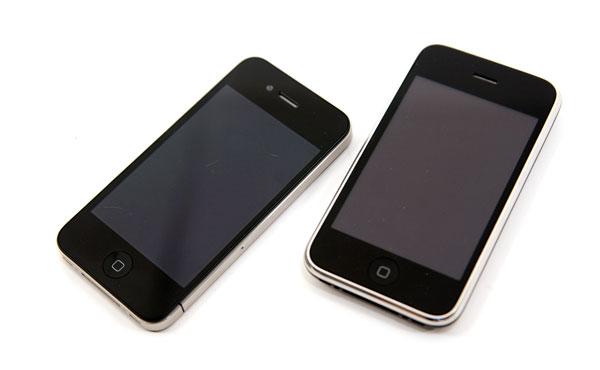
iPhone 4 (left) vs. iPhone 3GS (right)
The physical buttons (but not their layout) have changed on the 4. The ringer switch has shorter travel and feels sturdier as a result. The volume rocker has been replaced by discrete volume up/down buttons, also very sturdy in feel. The power/lock button is also now made out of stainless steel. Only the home button remains unchanged, although it does seem to make a deeper click when you use it.

The speaker moved to behind the right grill at the bottom of the phone instead of the left. The dock connector thankfully remained unchanged. It looks like Apple is committed to maintaining this connector until it makes the jump to something wireless (or optical?).

The back of the phone is pretty. Apple broke with tradition and finally included a single LED flash on the phone. The flash comes on in low light conditions and is enough to take shots in total darkness.
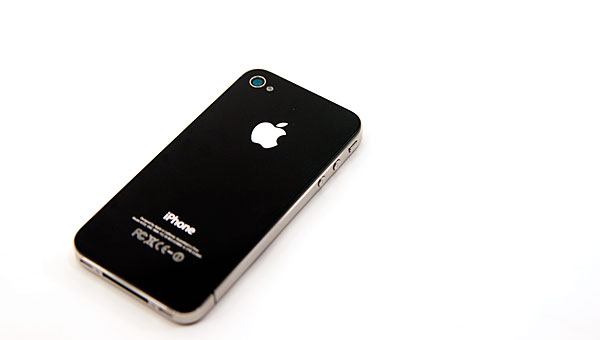
The camera has been upgraded to a low noise 5MP sensor. It can shoot stills at up to 2592 x 1936 or video at 1280 x 720 @ 30 fps. We’ll go into greater detail on its quality in the camera section. The iPhone 4 also adds a front facing camera capable of shooting both photos and video at 640 x 480.
Apple quotes contrast ratio as 1000:1, in our measurements we got very close (952:1). A significant improvement over the 188:1 ratio of the 3GS. Apple achieved this by both dropping black levels and increasing the white levels on the display. Improving both is always fine by me.
Internally the iPhone 4 uses Apple's new A4 SoC, built around an ARM Cortex A8 CPU and a PowerVR SGX GPU. The new SoC is built on a 45nm process and features 512MB of memory on the package. Apple hasn't made CPU clock speed public, but I'm guessing around 800MHz compared to the iPad's 1GHz for reasons you'll see later. GPU clock speed is unknown as well. Having more memory on package is an interesting move by Apple as it makes the iPhone 4 better suited for multitasking compared to the iPad. Also implying that shortly after the iPad gets multitasking it'll be updated to a version with more memory as well.
The iPhone now has an gyroscope as well the rotation sensors of its predecessors. Developers are given full access to the gyroscope making the iPhone 4 capable of becoming a very expensive Wii-mote.
| Physical Comparison | ||||||||
| Apple iPhone 4 | Apple iPhone 3GS | HTC EVO 4G (Qualcomm Snapdragon QSD8650) | HTC Droid Incredible (Qualcomm Snapdragon QSD8650) | Google Nexus One (Qualcomm Snapdragon QSD8250) | ||||
| Height | 115.2 mm (4.5") | 115 mm (4.5") | 121.9 mm (4.8") | 117.5 mm (4.63") | 119 mm (4.7") | |||
| Width | 58.6 mm (2.31") | 62.1 mm (2.44") | 66.0 mm (2.6") | 58.5 mm (2.30") | 59.8 mm (2.35") | |||
| Depth | 9.3 mm ( 0.37") | 12.3 mm (0.48") | 12.7 mm (0.5") | 11.9 mm (0.47") | 11.5 mm (0.45") | |||
| Weight | 137 g (4.8 oz) | 133 g (4.7 oz) | 170 g (6.0 oz) | 130 g (4.6 oz) | 130 g (4.6 oz) | |||
| CPU | Apple A4 @ ~800MHz | Apple/Samsung A3 @ 600MHz | Qualcomm Scorpion @ 1GHz | Qualcomm Scorpion @ 1GHz | Qualcomm Scorpion @ 1GHz | |||
| GPU | PowerVR SGX 535 | PowerVR SGX 535 | Adreno 200 | Adreno 200 | Adreno 200 | |||
| RAM | 512MB LPDDR1 (?) | 256MB LPDDR1 | 512MB LPDDR1 | 512MB LPDDR1 | 512MB LPDDR1 | |||
| NAND | 16GB or 32GB integrated | 16 or 32GB integrated | 8GB micro SD | 8GB micro SD | micro SD | |||
| Camera | 5MP with LED Flash + Front Facing Camera | 3MP | 8MP with dual LED Flash + Front Facing Camera | 8MP with LED Flash | 5MP with LED Flash | |||
| Screen | 3.5" 640 x 960 LED backlit LCD | 3.5" 320 x 480 | 4.3" 480 x 800 | 3.7" 480 x 800 AMOLED | 3.7" 480 x 800 AMOLED | |||
| Battery | Integrated 5.254Whr | Integrated 4.51Whr | Removable 5.5Whr | Removable 4.81 Whr | Removable 5.18 Whr | |||
The iPhone 4's logic board shrinks in size thanks to further component integration, making room for a much larger battery. The 5.25Whr battery in the iPhone 4 is a 16% increase from what was in the 3GS, and 95% of what HTC put in the EVO 4G. While raw performance improved, it's clear that Apple's focus this time around was battery life. Again, we'll dive into specifics later in the review.
Moving back outside Apple surrounded the phone with a stainless steel band. This band doubles as the 3G, WiFi and Bluetooth antennas. And if you hadn't noticed, it also moonlights as a giant elephant. Let's talk about it.










270 Comments
View All Comments
Mumrik - Friday, July 2, 2010 - link
Stop that shit. We all know major iPhone (iPod, Windows, Intel CPU etc.) releases matter more for the industry and the majority of people so it is only natural that they put more work into these articles that are going to get more readers. There is one iPhone out there at a time but a gazillion competing Android phones. They can't cover them all like this - that is why they put extra effort into articles that cover Android itself.I say this as someone who has sworn to never own an Apple product.
Henry 3 Dogg - Thursday, July 1, 2010 - link
Re your final comment"Changing the bars visualization may indeed help mask it [the signal drop], and to be fair the phone works fine all the way down to -113 dBm, but it will persist - software updates can change physics as much as they can change hardware design."
From my own tests, I think that you are missing something here.
When you bridge the left corner line and see the signal strength drop, it does so over the course of several seconds. One would tend to assume that this is time averaging in software BUT...
if you make a call in a very weak signal area and then bridge the gap, the call degrades and possibly drops in the same way i.e. over the course of several seconds.
If the whole effect is physics, then the call should degrade instantly - but it doesn't.
Clearly there is a physics effect, but it also appears that the phone software is responding to this physics effect in a manner that makes it more of an issue.
It may/should be possible, by software changes, to make the final signal degradation when the gap is bridged, no more that it is immediately the gap is bridged, and in all honesty that would pretty much close the issue.
Personally I just don't bridge the gap, and then I find, like you did, that I can simply use this phone in places that I've never been able to use a mobile before.
This really is the best phone yet.
John Sawyer - Thursday, July 1, 2010 - link
"It may/should be possible, by software changes, to make the final signal degradation when the gap is bridged, no more that it is immediately the gap is bridged, and in all honesty that would pretty much close the issue."Hopefully this is what Jobs meant when he said, "Stay tuned."
mmike70 - Friday, July 2, 2010 - link
Maybe calls are more forgiving because I haven't had one drop yet. What does happen is when I hold the iphone4 normally in my left hand (I'm right handed, tap with the right hand fingers, hold with the left), the data connection drops immediately. I'm not talking even over the course of five seconds. The currently loading web page will stall the instant I pick the phone up. This is in an area with a very close tower, constant 5 bars on an iphone 4 and 3gs. I can't cradle, grip, pinch, cover, etc the 3gs to make any detectable difference in data performance.chinkgai - Thursday, July 1, 2010 - link
Hey Brian or Anand,Just wanted to point out that on my wireless N/G with the same speedtest.net app tests, my download speed usually always tops out around 10700-11000 kbps, so I'm not sure why you're getting such a low speed on average. It also maxes out my upload speed which is far lower than yours. I'm on a 16/2 line here in Los Angeles.
Great article though!!
bparun - Thursday, July 1, 2010 - link
Obviously a good thorough review. Why is there not a good amount of detail about the newly added Gyroscope in iPhone 4? I have read that its the electronic version of a vibrational one. More on that would be a nice read, as the future of games and apps using this gyroscope for augmented reality would be in abundance. I am sure all the other phone manufacturers are ready to follow, as usual.Mumrik - Friday, July 2, 2010 - link
Such a minor feature in the larger perspective...John Sawyer - Thursday, July 1, 2010 - link
It seems to me, that if the iPhone 4's signal is attenuated when one's hand bridges the gap between the two antennas on the lower left side, but not if one bridges the two antennas by holding the iPhone 4 at its sides, above the gap, that one possible fix for the future, might be to move the gaps so that they're at the topside left and underside left, so one's hand (left or right) doesn't touch the gaps (I doubt many people cover the bottom or top edges of their phones while in use). This would allow the lengths of the two antennas to remain nearly the same, and so it might not compromise the original antenna design's signal strength, unless the original design relies on the upper and lower left corners/ends of the two antennas to be untouched by a user's hand, which would be stupidly unnatural (as nearly everyone notes). If full antenna strength does require these two corners/ends to be uncovered, does this mean the iPhone 4's main radiating signal power, for both antennas, emits from the upper and lower left corners/curved ends of the two antennas, rather than from the entire length of the antennas? If the entire length of both antennas send/receive, moving the gaps to topside left and underside left wouldn't seem to greatly affect the right-side UMTS/GSM antenna's exposure to the world (more critical than the left Bluetooth/wifi/GPS antenna's exposure, since a cell tower is usually further away than a local wireless router, etc.), no matter which hand it's held in (can't say the same for the left-hand antenna, but that may not be important due to closer proximity of wireless routers, etc.); but if the signals for both antennas send/receive mainly from one end of each antenna (currently the curved ends), requiring them to have some uncovered access to the world, then what about moving the gaps closer to the center-top and center-bottom locations? I have a hunch that these potential end-radiating points don't have to be curved, as they currently are at the corners, but maybe I'm wrong. However, this would make both antennas nearly the same length, which might affect signal strength too, if the different frequencies sent/received by the two antennas require their lengths to be as they currently are.
If Apple doesn't want do anything like that (or if the antenna design doesn't allow for it), or even to coat the exposed metal antenna with some kind of clear coat (if that even helps enough), it might be best to move the antennas back inside, wrapped around the inside of the case--I don't think too many users will moan about not being able to touch metal around the sides of the iPhone. Another approach (which would work for either internal or external antennas) might further improve the antenna: two antennas for the phone signal, one at each lower corner (since FCC phone-to-head maximum radio signal level requirements now force manufacturers to put the phone antenna in the bottom of new cellphones), with whichever one that's not covered by the user's hand being used (circuitry in the phone could detect this).
iwod - Thursday, July 1, 2010 - link
1. I dont know why no one mentioned it in their reviews. And only Anand manages to point out my same thoughts, Why no insulation coating on the Stainless steel? It add less then 1mm of thickness and is cheap and easy enough to do so.The only reason would be Apple Engineer were using 3GS casing while they were testing..
2. No one mentioned the new Skyworks Baseband chip. I have never head of them, and dont know how good they are. Wiki shows they have been in the business for nearly a decade now, so that should be good. The Less Drop calls on iPhone 4 were more to do with this Chips instead of AT&T network upgrade. The previous Infineon Chipset were simply poor. It was Infineon first chip into communication and mobile network. And it didn't work well although the problem were easily pointed to AT&T network. It wasn't only AT&T were having drop calls, Every iPhone 3G user in the world were having drop calls with different Network. And the Drop Calls rate for iPhone 3G/3GS on AT&T were much higher then any other phones on AT&T network. That simply points to a problem the lies within iPhone.
3. The iPhone A4 is a package on package SOC. The Memory was Dual Channel Low Power DDR. Why didn't they use Low Power DDR3? It is lower power and faster then ancients DDR.
4. Why didn't Apple upgrade their GPU? The iPhone 4 is 4x as much resolution. Playing Games on it requires much more computational power.
5. 110ppi may not be enough for desktop. But how many ppi would a Retina Display for Desktop and Notebook need? I just measure we are typlically at least 24 inch away from the monitor, double the distance as you would hold on a iPhone. If a iPhone 4 requires 330 ppi, then Double the distance would half the ppi, which means 165ppi, That means 2560 x 1200 Resolution for 18" Display. For a Large Desktop Display 27", you will need 4K ( 4096×1716 ) resolution, which is actually perfect for Digital Film making and Broadcasting. I think it is time we distinguish a Computer Display to Normal TV. They can keep with their 1080P for as long as they want. We want Retina Display on our Mac.
( Notes: However even the lastest DisplayPort 1.2 does not offer enough bandwidth for 4K resolution )
6. Software Side - Some Reports indicate iOS 4.0 uses more memory then older iOS 3.0 which more useless process standby ( Such us Internet tethering and Bluetooth.exe even when both features are OFF ). While they may only consumer 2 - 3MB of memory. It is still a lot on a mobile devices. I hope anand can verify if they have time.
7. Saferi on iOS 4.0 seems to be using a older version of WebKit as well. I am sure SunSpider will run faster and on par with Andriod once Apple update iOS.
brownreese - Thursday, July 1, 2010 - link
I am blown away by the thoughtfulness of this review. Too many sites read like regurgitated press releases. I have just become a lifelong reader. Thanks.